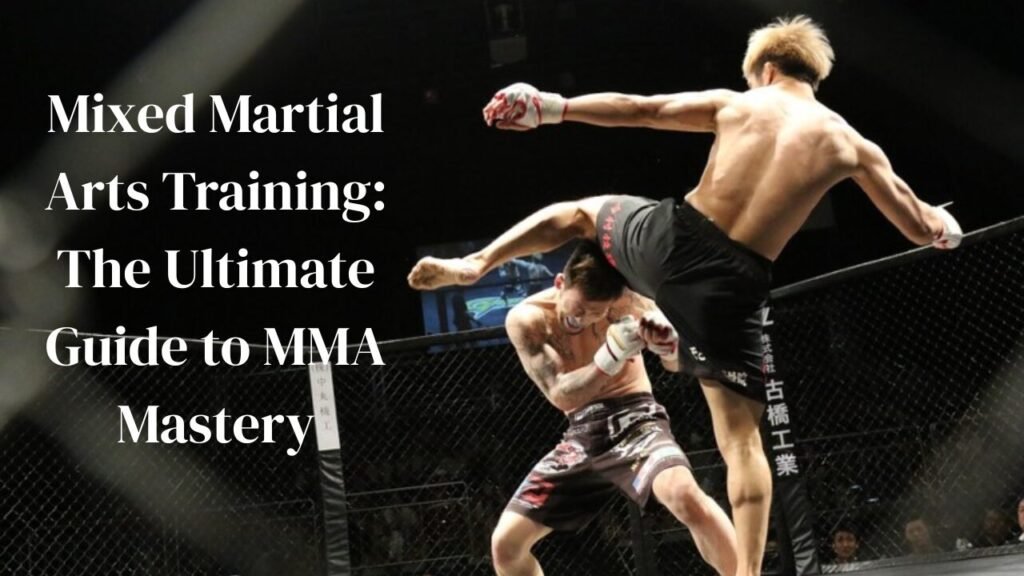Mixed Martial Arts Training is much more than a simple workout it’s a complete lifestyle, combining physical fitness, mental toughness, and personal discipline. Whether you’re aiming to compete professionally, improve your physical health, learn self defense, or simply challenge yourself, MMA offers a dynamic and rewarding path. It merges various combat disciplines, including boxing, Muay Thai, Brazilian Jiu Jitsu, wrestling, and more, creating a versatile and highly effective training system.
This guide will walk you through the essentials of MMA training. You’ll learn about foundational techniques in both striking and grappling, the physical and mental benefits of regular training, and how to get started regardless of your current fitness level. We’ll also provide practical tips to help you stay motivated, avoid injuries, and make steady progress.
Whether you’re a beginner or someone with experience in martial arts, understanding the structure and benefits of MMA can change your approach to fitness and personal growth. By the end of this guide, you’ll see how MMA not only builds strength and endurance but also cultivates confidence, discipline, and resilience. Embrace the journey, and discover how MMA training can positively impact every area of your life.
What is Mixed Martial Arts?
Mixed Martial Arts, or MMA, is a full contact combat sport that combines techniques from various martial arts disciplines like boxing, Brazilian Jiu Jitsu, Muay Thai, wrestling, judo, and karate. Fighters use both striking and grappling skills, standing or on the ground.
MMA’s popularity skyrocketed with organizations like the UFC (Ultimate Fighting Championship) showcasing high-level competition globally. Today, MMA is practiced not just by professional fighters but also by fitness enthusiasts, law enforcement personnel, and everyday individuals looking for a complete physical and mental challenge.
Fun Fact: According to boxing essential, the term “mixed martial arts” was first documented in 1993 during the early UFC broadcasts.
Benefits of Mixed Martial Arts Training
Mixed martial arts training offers an impressive array of benefits that go far beyond just fighting skills.
Physical Conditioning
- Builds full body strength
- Increases cardiovascular endurance
- Enhances coordination and flexibility
Mental Fortitude
- Improves focus and discipline
- Builds resilience and confidence
- Teaches patience and adaptability under pressure
Self Defense
- Equips you with real-world techniques to protect yourself
- Teaches you how to stay calm and respond strategically
Essential Components of MMA Training
Training in MMA is multi faceted. Here are the core components you’ll find in a well-rounded program:
1. Striking
- Includes techniques from boxing, kickboxing, and Muay Thai
- Focus on jabs, crosses, hooks, elbows, and leg kicks
2. Grappling
- Draws from Brazilian Jiu Jitsu, wrestling, and judo
- Teaches takedowns, submissions, escapes, and clinch control
3. Strength and Conditioning
- Circuit training, weightlifting, plyometrics, and cardio drills
- Helps develop explosive power and fight endurance
4. Drills and Sparring
- Partner drills simulate real combat scenarios
- Controlled sparring sharpens timing, reflexes, and adaptability
Recommended Resource: The Ultimate Mixed Martial Arts Training Guide is a great book for beginners and advanced students looking to deepen their understanding of MMA systems.
How to Get Started with MMA Training
Step 1: Choose the Right Gym
Look for a reputable MMA academy like Elite MMA, known for its experienced instructors and structured programs. Things to consider:
- Certified coaches (preferably with competition experience)
- Clean facilities with proper safety gear
- Class variety (striking, grappling, cardio)
- Community and student reviews
Elite MMA: Rated 4.9 stars from 300+ Google Reviews, with locations across Texas and a strong reputation in the MMA community.
Step 2: Gear Up
Basic MMA gear includes:
- MMA gloves (4oz for competition, 7–10oz for training)
- Mouthguard
- Hand wraps
- Shin guards
- Rashguard and compression shorts
Step 3: Start Slow and Be Consistent
It’s easy to get overwhelmed in the beginning. Focus on:
- Learning proper form before going hard
- Attending 2-3 classes per week
- Setting short-term goals (e.g., improving footwork or landing clean jabs)
Mixed Martial Arts for Fitness (Not Just Fighters!)
Even if you don’t plan to step into the cage, MMA offers incredible fitness benefits. Many MMA gyms offer classes designed for people who want to:
- Burn fat
- Build lean muscle
- Improve agility and core strength
These classes are fun, high energy, and often include:
- Pad work
- Bag drills
- Partner drills
- Bodyweight circuits
MMA burns between 600–900 calories per hour more than most traditional workouts!
FAQs
What age is best to start MMA training?
There’s no ideal age. Many start as kids (ages 5–7), while others begin in their 30s or 40s. What matters most is consistency and finding the right program for your fitness level.
Can I train MMA if I’m out of shape?
Absolutely. Most gyms welcome beginners with no prior experience. Start slow and let your conditioning improve naturally over time.
Is MMA dangerous?
When trained responsibly under proper guidance, MMA is relatively safe. Injuries can happen, but they’re often minor. Quality gyms prioritize safety during drills and sparring.
How long does it take to become proficient?
Depending on your frequency and effort, you can become well-rounded in 12–18 months. Mastery, of course, is a lifelong journey.
What’s the difference between MMA and other martial arts?
Traditional martial arts (like karate or taekwondo) focus on specific techniques and styles. MMA integrates multiple styles, allowing practitioners to adapt based on real world or competitive scenarios.
Expert Tips for Long Term MMA Progress
- Track Your Progress: Keep a journal or app record of techniques learned, fitness stats, and sparring reflections.
- Cross Train: Add yoga, swimming, or strength training to support mobility and prevent burnout.
- Find a Mentor: Learn from experienced fighters or coaches who can guide your growth.
- Watch Fights Intelligently: Study UFC matches to understand high level strategies.
- Stay Humble: MMA is a humbling art; embrace being a beginner and learning from your losses.
Conclusion
Mixed martial arts training is more than just a combat sport it’s a comprehensive journey toward fitness, confidence, discipline, and personal growth. Whether you’re aspiring to step into the cage as a competitor or simply looking to push your physical and mental limits, MMA provides a powerful outlet for transformation. Through rigorous training that blends striking, grappling, and conditioning, you’ll build strength, endurance, and resilience both inside and outside the gym.
So lace up your gloves, step onto the mat, and take the first step into the world of mixed martial arts. It could become the most empowering choice of your life.




